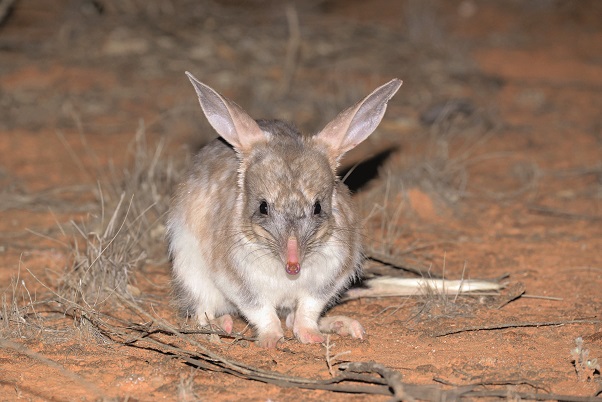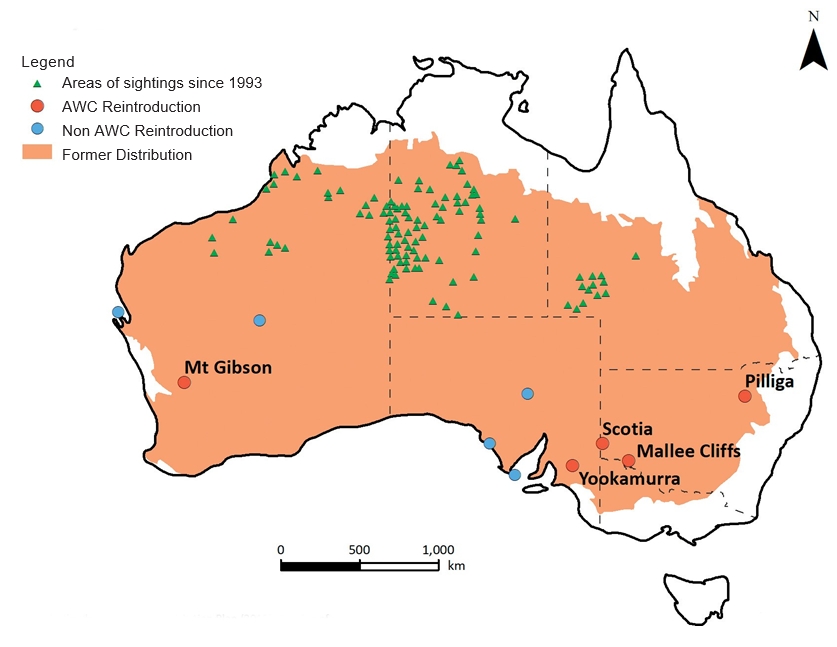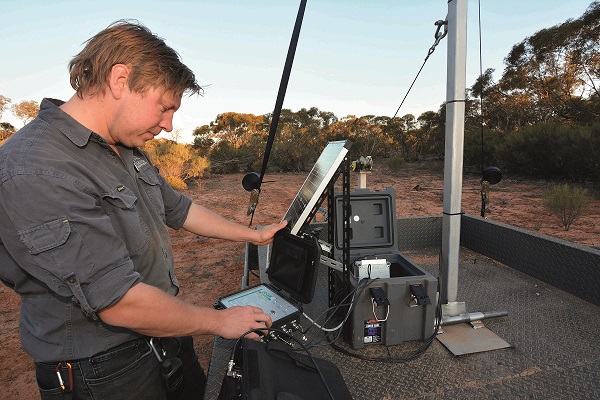By Dr Laurence Berry, Wildlife Ecologist, and Bruce Summerfield, Operations Manager
For the first time in a century, the Greater Bilby (Macrotis lagotis) has been returned to the woodland habitats of Mallee Cliffs National Park, in far-western New South Wales. Fifty Bilbies were reintroduced in October, marking another important milestone in Australian Wildlife Conservancy’s partnership with the NSW National Parks and Wildlife Service.
At a time when populations of this nationally threatened species are under stress from drought and feral predators, the establishment of this new population is a critical step in Bilby conservation. The project is ultimately predicted to result in a 10 per cent increase in the global population of the species.
 © Wayne Lawler/AWC
© Wayne Lawler/AWC
Construction of the 9,570 hectare fenced area at Mallee Cliffs National Park represents one of the most significant pieces of conservation infrastructure in Australia. Over 42 kilometres of conservation fencing and 54 kilometres of new tracks were installed in just six months, with the fence itself completed in a record 12 weeks. The team overcame intense heat, dust and very hard Mallee stumps to get the job done. The finished fence consists of 378 kilometres of plain wire, 504,000 fence clips, 8,400 star posts, and eight heavy-duty gates. AWC staff inspected over 440 trees to ensure valuable ecological features, such as hollows, were retained. This approach has paid off, with one of the released Bilbies tracked to a den site under a fallen tree retained as habitat.
The feral animal eradication process commenced in 2017, prior to fence construction, when AWC’s skilled and experienced land management team undertook intensive fox control across the park. The breeding area was declared feral-free in June 2019, with the larger area on track for feral eradication by March 2020. The outcomes of the eradication effort, undertaken by five full-time feral animal control officers, is monitored using 89 camera traps deployed within the fence. Since 2017, the operations team has deployed more than 2,500 fresh baits, conducted 100,000 Canid Pest Ejector nights and dragged over 1,500 kilometres of tracks.

AWC ecologists undertook three separate translocations to source the founding population of Bilbies for Mallee Cliffs National Park. The first translocation involved over a dozen AWC staff across three locations. At the start of October, a team of eight AWC ecologists flew to Thistle Island in South Australia, which supports a wild, reintroduced population of Bilbies. In total, 68 individuals were caught over two nights. Of these, 30 Bilbies (15 males and 15 females, some with pouch young) were selected for translocation based on strict criteria including condition, age and health. They were then transferred by charter flight to AWC’s Yookamurra Wildlife Sanctuary where local AWC staff, accompanied by a veterinarian, conducted health checks, fitted radio-transmitters and took physical measurements from the animals. The following morning the animals were airlifted to Mallee Cliffs National Park and released after dark into the fenced area.
The 30 founding animals from Thistle Island have been joined by 10 additional Bilbies from AWC’s Scotia Wildlife Sanctuary, and 10 captive-bred animals from various zoos. The Bilbies have been sourced according to genetic advice provided by researchers at Sydney University, in collaboration with AWC. Sourcing founders from different populations will promote the genetic diversity of the population and hence, adaptive capacity, such as resilience to environmental change. To encourage interbreeding, the Bilbies have been released into a specially designed, 480 hectare breeding area. The Bilbies will be released into the 9,500 hectare area once it has been declared feral free.
AWC ecologists are closely monitoring the survival of the released animals using a custom made coded VHF telemetry system that has been specifically designed for this project. Ten Bilbies from each source population have been fitted with small, 10 gram radio transmitters attached to their tails. These transmitters emit a unique code enabling the survival of each individual to be tracked. The data are captured in the field using a receiver attached to a tower that can detect animals within a one kilometre radius.
One month after their release, the Bilbies are settling in well. Survival monitoring indicates a 97 per cent survival rate of radio-tracked individuals, which demonstrates the extraordinary short-term success of the reintroduction. There are clear signs that the Bilbies are adapting to their new home with diggings clearly visible throughout the fenced area. Many of the Bilbies have dug their own burrows. Several individuals have excavated old rabbit warrens and some have constructed homes under fallen trees. Follow-up trapping early next year will provide further insights into the establishment of the population and the success of the reintroduction.
 © Wayne Lawler/AWC
© Wayne Lawler/AWC
The Bilby is the first of 10 regionally-extinct mammals to be restored to Mallee Cliffs National Park as part of an innovative and ambitious partnership between AWC and National Parks and Wildlife Service. The other nine species to be reintroduced are the Western Quoll (Dasyurus geoffroii), Red-tailed Phascogale (Phascogale calura), Numbat (Myrmecobius fasciatus), Western Barred Bandicoot (Perameles bougainville), Bridled Nailtail Wallaby (Onychogalea fraenata), Burrowing Bettong (Bettongia lesueur), Brush-tailed Bettong (Bettongia penicillata), Greater Stick-nest Rat (Leporillus conditor) and Mitchell’s Hopping-mouse (Notomys mitchellii).
Few projects have ever made such a significant contribution to the conservation of Australia’s threatened mammal species. Funding for the construction of the fence, feral eradication, land management and species reintroduction has been provided by the NSW State Government as part of its $41.3 million Reintroduction of Locally Extinct Mammals Project (implemented across three NSW parks) and part of the Saving our Species program. As part of our contribution to the partnership, AWC will construct a dedicated field operations base for our staff working on site.